Business Research Design: Investigating ALDI Employee Turnover
VerifiedAdded on 2022/10/12
|18
|5365
|169
Report
AI Summary
This research design investigates the impact of human resource management (HRM) on employee turnover, using ALDI as a case study. The introduction highlights the high turnover rates at ALDI, linking it to work pressure and lack of work-life balance despite competitive pay. The research aims to identify HRM issues and recommend strategies for improvement, focusing on work-life balance as a critical factor. The objectives include examining the impact of HRM, highlighting workforce issues, and recommending solutions. The research questions address the critical issues faced by employees and the influence of work-life balance on turnover. The literature review explores the impact of HRM practices, employee turnover intention, and the importance of work-life balance, drawing on various studies. It highlights how HRM practices like training, development, and work-life balance initiatives can affect employee satisfaction, retention, and overall organizational performance. The study emphasizes the need for improvements in HRM policies to reduce turnover and enhance employee well-being, ultimately benefiting ALDI's strategic and cultural development.
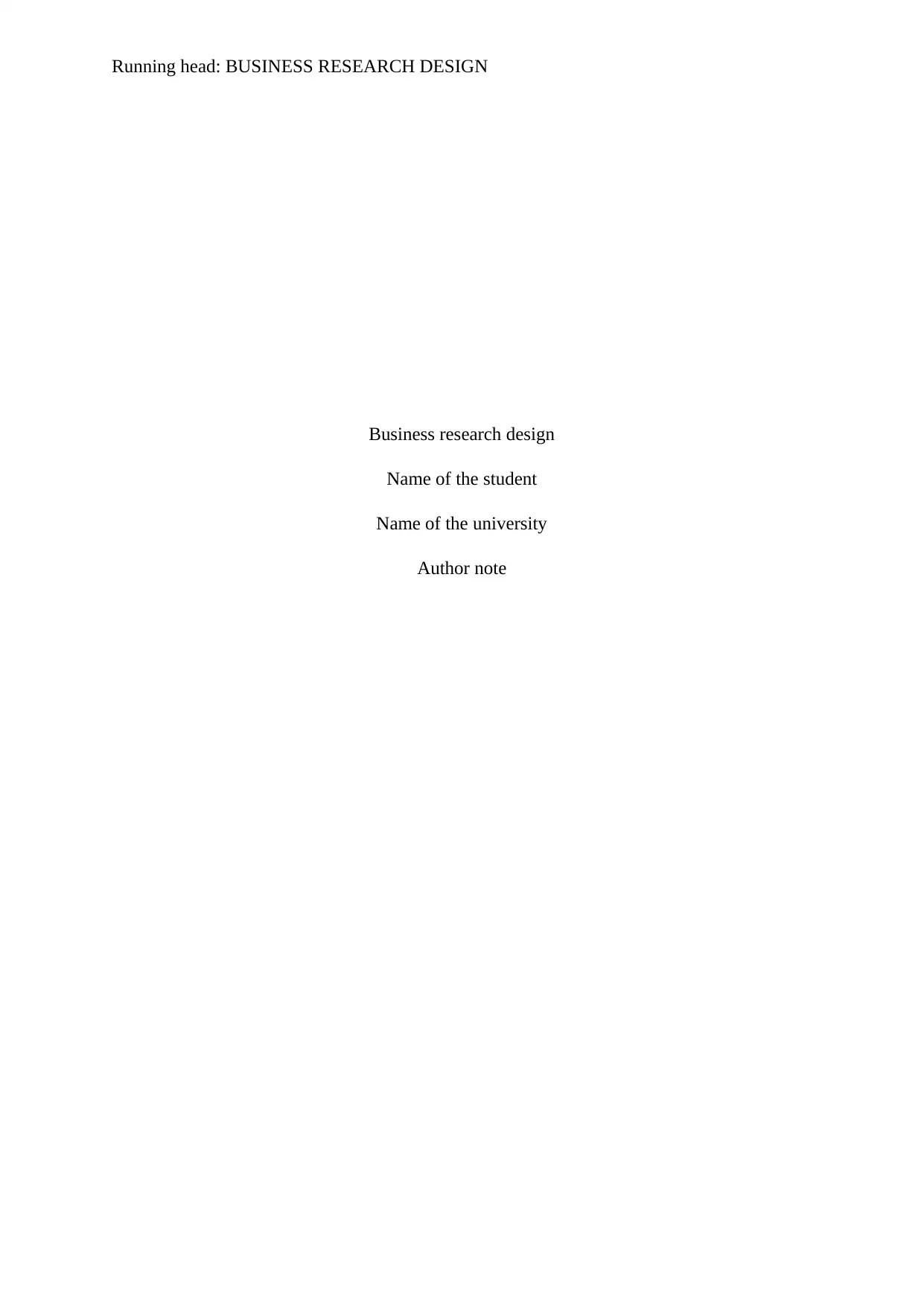
Running head: BUSINESS RESEARCH DESIGN
Business research design
Name of the student
Name of the university
Author note
Business research design
Name of the student
Name of the university
Author note
Paraphrase This Document
Need a fresh take? Get an instant paraphrase of this document with our AI Paraphraser
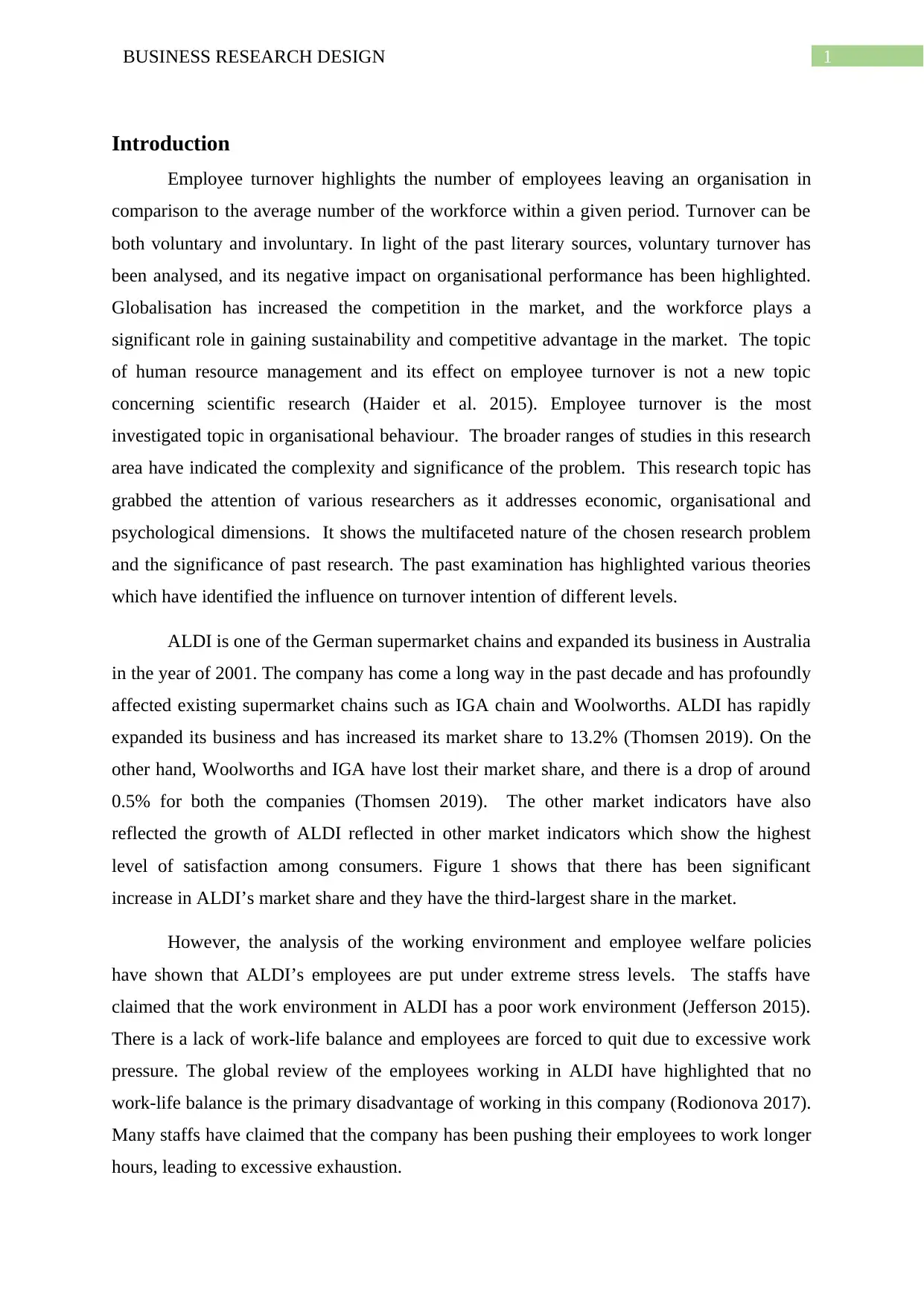
1BUSINESS RESEARCH DESIGN
Introduction
Employee turnover highlights the number of employees leaving an organisation in
comparison to the average number of the workforce within a given period. Turnover can be
both voluntary and involuntary. In light of the past literary sources, voluntary turnover has
been analysed, and its negative impact on organisational performance has been highlighted.
Globalisation has increased the competition in the market, and the workforce plays a
significant role in gaining sustainability and competitive advantage in the market. The topic
of human resource management and its effect on employee turnover is not a new topic
concerning scientific research (Haider et al. 2015). Employee turnover is the most
investigated topic in organisational behaviour. The broader ranges of studies in this research
area have indicated the complexity and significance of the problem. This research topic has
grabbed the attention of various researchers as it addresses economic, organisational and
psychological dimensions. It shows the multifaceted nature of the chosen research problem
and the significance of past research. The past examination has highlighted various theories
which have identified the influence on turnover intention of different levels.
ALDI is one of the German supermarket chains and expanded its business in Australia
in the year of 2001. The company has come a long way in the past decade and has profoundly
affected existing supermarket chains such as IGA chain and Woolworths. ALDI has rapidly
expanded its business and has increased its market share to 13.2% (Thomsen 2019). On the
other hand, Woolworths and IGA have lost their market share, and there is a drop of around
0.5% for both the companies (Thomsen 2019). The other market indicators have also
reflected the growth of ALDI reflected in other market indicators which show the highest
level of satisfaction among consumers. Figure 1 shows that there has been significant
increase in ALDI’s market share and they have the third-largest share in the market.
However, the analysis of the working environment and employee welfare policies
have shown that ALDI’s employees are put under extreme stress levels. The staffs have
claimed that the work environment in ALDI has a poor work environment (Jefferson 2015).
There is a lack of work-life balance and employees are forced to quit due to excessive work
pressure. The global review of the employees working in ALDI have highlighted that no
work-life balance is the primary disadvantage of working in this company (Rodionova 2017).
Many staffs have claimed that the company has been pushing their employees to work longer
hours, leading to excessive exhaustion.
Introduction
Employee turnover highlights the number of employees leaving an organisation in
comparison to the average number of the workforce within a given period. Turnover can be
both voluntary and involuntary. In light of the past literary sources, voluntary turnover has
been analysed, and its negative impact on organisational performance has been highlighted.
Globalisation has increased the competition in the market, and the workforce plays a
significant role in gaining sustainability and competitive advantage in the market. The topic
of human resource management and its effect on employee turnover is not a new topic
concerning scientific research (Haider et al. 2015). Employee turnover is the most
investigated topic in organisational behaviour. The broader ranges of studies in this research
area have indicated the complexity and significance of the problem. This research topic has
grabbed the attention of various researchers as it addresses economic, organisational and
psychological dimensions. It shows the multifaceted nature of the chosen research problem
and the significance of past research. The past examination has highlighted various theories
which have identified the influence on turnover intention of different levels.
ALDI is one of the German supermarket chains and expanded its business in Australia
in the year of 2001. The company has come a long way in the past decade and has profoundly
affected existing supermarket chains such as IGA chain and Woolworths. ALDI has rapidly
expanded its business and has increased its market share to 13.2% (Thomsen 2019). On the
other hand, Woolworths and IGA have lost their market share, and there is a drop of around
0.5% for both the companies (Thomsen 2019). The other market indicators have also
reflected the growth of ALDI reflected in other market indicators which show the highest
level of satisfaction among consumers. Figure 1 shows that there has been significant
increase in ALDI’s market share and they have the third-largest share in the market.
However, the analysis of the working environment and employee welfare policies
have shown that ALDI’s employees are put under extreme stress levels. The staffs have
claimed that the work environment in ALDI has a poor work environment (Jefferson 2015).
There is a lack of work-life balance and employees are forced to quit due to excessive work
pressure. The global review of the employees working in ALDI have highlighted that no
work-life balance is the primary disadvantage of working in this company (Rodionova 2017).
Many staffs have claimed that the company has been pushing their employees to work longer
hours, leading to excessive exhaustion.
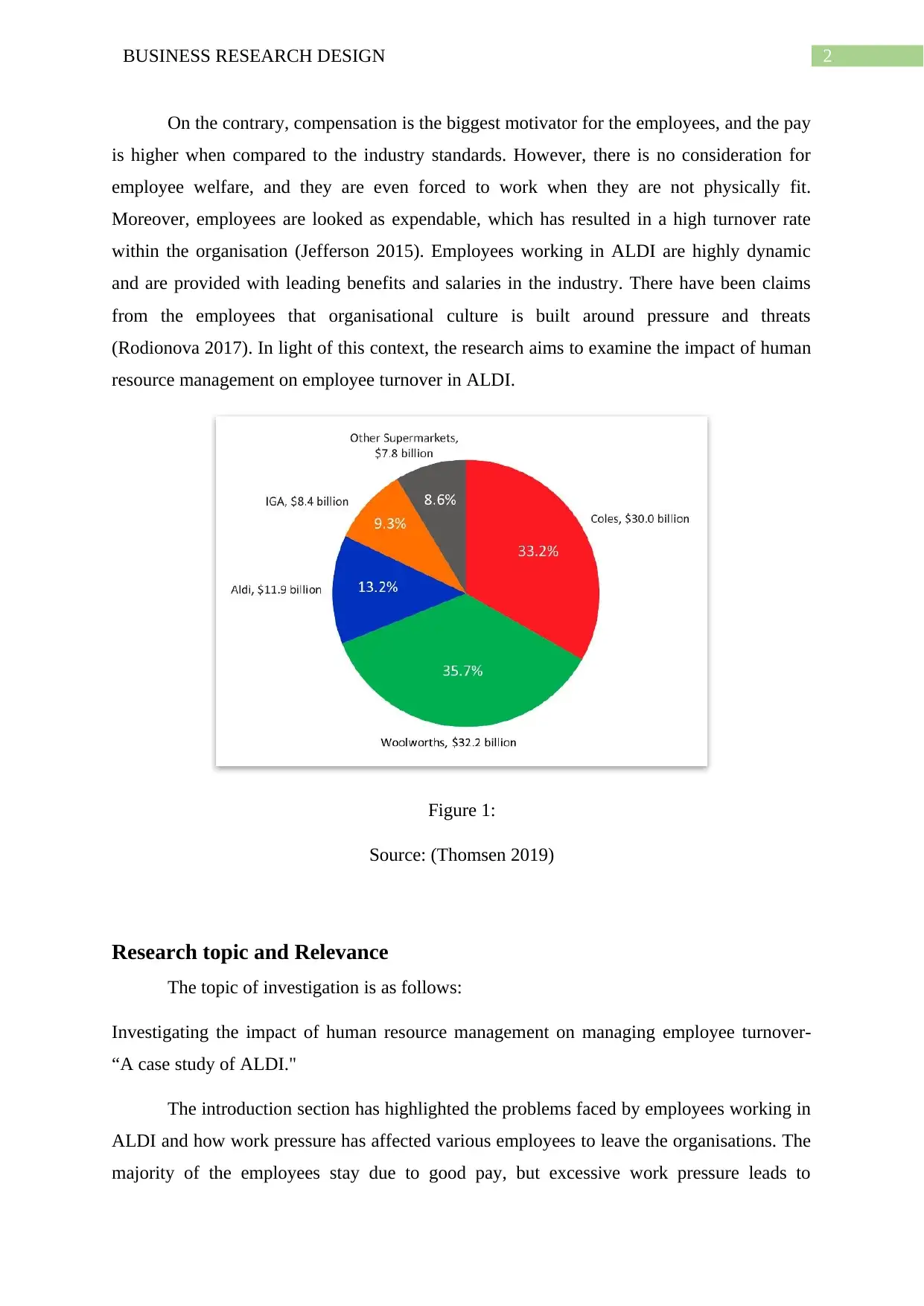
2BUSINESS RESEARCH DESIGN
On the contrary, compensation is the biggest motivator for the employees, and the pay
is higher when compared to the industry standards. However, there is no consideration for
employee welfare, and they are even forced to work when they are not physically fit.
Moreover, employees are looked as expendable, which has resulted in a high turnover rate
within the organisation (Jefferson 2015). Employees working in ALDI are highly dynamic
and are provided with leading benefits and salaries in the industry. There have been claims
from the employees that organisational culture is built around pressure and threats
(Rodionova 2017). In light of this context, the research aims to examine the impact of human
resource management on employee turnover in ALDI.
Figure 1:
Source: (Thomsen 2019)
Research topic and Relevance
The topic of investigation is as follows:
Investigating the impact of human resource management on managing employee turnover-
“A case study of ALDI."
The introduction section has highlighted the problems faced by employees working in
ALDI and how work pressure has affected various employees to leave the organisations. The
majority of the employees stay due to good pay, but excessive work pressure leads to
On the contrary, compensation is the biggest motivator for the employees, and the pay
is higher when compared to the industry standards. However, there is no consideration for
employee welfare, and they are even forced to work when they are not physically fit.
Moreover, employees are looked as expendable, which has resulted in a high turnover rate
within the organisation (Jefferson 2015). Employees working in ALDI are highly dynamic
and are provided with leading benefits and salaries in the industry. There have been claims
from the employees that organisational culture is built around pressure and threats
(Rodionova 2017). In light of this context, the research aims to examine the impact of human
resource management on employee turnover in ALDI.
Figure 1:
Source: (Thomsen 2019)
Research topic and Relevance
The topic of investigation is as follows:
Investigating the impact of human resource management on managing employee turnover-
“A case study of ALDI."
The introduction section has highlighted the problems faced by employees working in
ALDI and how work pressure has affected various employees to leave the organisations. The
majority of the employees stay due to good pay, but excessive work pressure leads to
⊘ This is a preview!⊘
Do you want full access?
Subscribe today to unlock all pages.

Trusted by 1+ million students worldwide
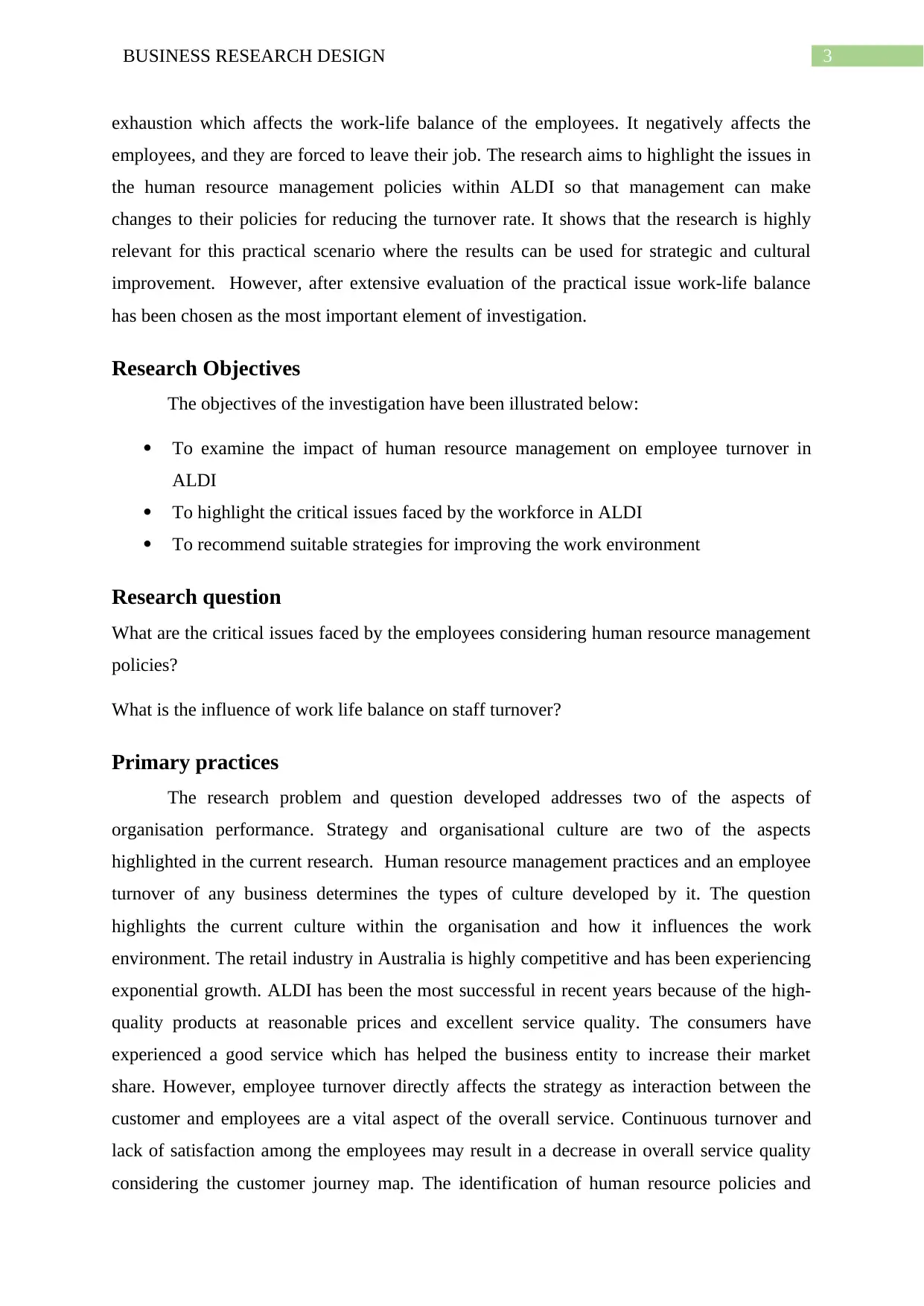
3BUSINESS RESEARCH DESIGN
exhaustion which affects the work-life balance of the employees. It negatively affects the
employees, and they are forced to leave their job. The research aims to highlight the issues in
the human resource management policies within ALDI so that management can make
changes to their policies for reducing the turnover rate. It shows that the research is highly
relevant for this practical scenario where the results can be used for strategic and cultural
improvement. However, after extensive evaluation of the practical issue work-life balance
has been chosen as the most important element of investigation.
Research Objectives
The objectives of the investigation have been illustrated below:
To examine the impact of human resource management on employee turnover in
ALDI
To highlight the critical issues faced by the workforce in ALDI
To recommend suitable strategies for improving the work environment
Research question
What are the critical issues faced by the employees considering human resource management
policies?
What is the influence of work life balance on staff turnover?
Primary practices
The research problem and question developed addresses two of the aspects of
organisation performance. Strategy and organisational culture are two of the aspects
highlighted in the current research. Human resource management practices and an employee
turnover of any business determines the types of culture developed by it. The question
highlights the current culture within the organisation and how it influences the work
environment. The retail industry in Australia is highly competitive and has been experiencing
exponential growth. ALDI has been the most successful in recent years because of the high-
quality products at reasonable prices and excellent service quality. The consumers have
experienced a good service which has helped the business entity to increase their market
share. However, employee turnover directly affects the strategy as interaction between the
customer and employees are a vital aspect of the overall service. Continuous turnover and
lack of satisfaction among the employees may result in a decrease in overall service quality
considering the customer journey map. The identification of human resource policies and
exhaustion which affects the work-life balance of the employees. It negatively affects the
employees, and they are forced to leave their job. The research aims to highlight the issues in
the human resource management policies within ALDI so that management can make
changes to their policies for reducing the turnover rate. It shows that the research is highly
relevant for this practical scenario where the results can be used for strategic and cultural
improvement. However, after extensive evaluation of the practical issue work-life balance
has been chosen as the most important element of investigation.
Research Objectives
The objectives of the investigation have been illustrated below:
To examine the impact of human resource management on employee turnover in
ALDI
To highlight the critical issues faced by the workforce in ALDI
To recommend suitable strategies for improving the work environment
Research question
What are the critical issues faced by the employees considering human resource management
policies?
What is the influence of work life balance on staff turnover?
Primary practices
The research problem and question developed addresses two of the aspects of
organisation performance. Strategy and organisational culture are two of the aspects
highlighted in the current research. Human resource management practices and an employee
turnover of any business determines the types of culture developed by it. The question
highlights the current culture within the organisation and how it influences the work
environment. The retail industry in Australia is highly competitive and has been experiencing
exponential growth. ALDI has been the most successful in recent years because of the high-
quality products at reasonable prices and excellent service quality. The consumers have
experienced a good service which has helped the business entity to increase their market
share. However, employee turnover directly affects the strategy as interaction between the
customer and employees are a vital aspect of the overall service. Continuous turnover and
lack of satisfaction among the employees may result in a decrease in overall service quality
considering the customer journey map. The identification of human resource policies and
Paraphrase This Document
Need a fresh take? Get an instant paraphrase of this document with our AI Paraphraser
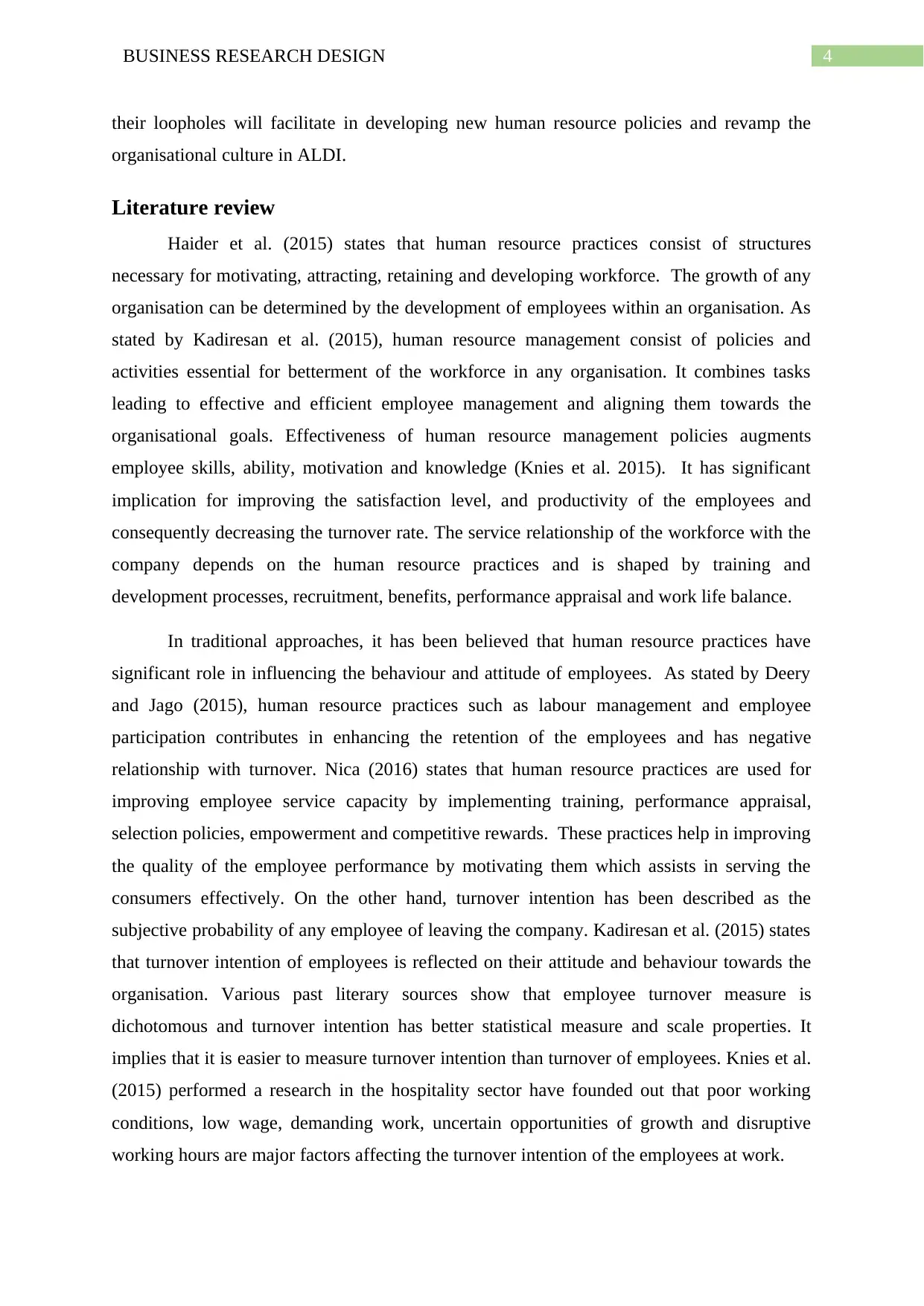
4BUSINESS RESEARCH DESIGN
their loopholes will facilitate in developing new human resource policies and revamp the
organisational culture in ALDI.
Literature review
Haider et al. (2015) states that human resource practices consist of structures
necessary for motivating, attracting, retaining and developing workforce. The growth of any
organisation can be determined by the development of employees within an organisation. As
stated by Kadiresan et al. (2015), human resource management consist of policies and
activities essential for betterment of the workforce in any organisation. It combines tasks
leading to effective and efficient employee management and aligning them towards the
organisational goals. Effectiveness of human resource management policies augments
employee skills, ability, motivation and knowledge (Knies et al. 2015). It has significant
implication for improving the satisfaction level, and productivity of the employees and
consequently decreasing the turnover rate. The service relationship of the workforce with the
company depends on the human resource practices and is shaped by training and
development processes, recruitment, benefits, performance appraisal and work life balance.
In traditional approaches, it has been believed that human resource practices have
significant role in influencing the behaviour and attitude of employees. As stated by Deery
and Jago (2015), human resource practices such as labour management and employee
participation contributes in enhancing the retention of the employees and has negative
relationship with turnover. Nica (2016) states that human resource practices are used for
improving employee service capacity by implementing training, performance appraisal,
selection policies, empowerment and competitive rewards. These practices help in improving
the quality of the employee performance by motivating them which assists in serving the
consumers effectively. On the other hand, turnover intention has been described as the
subjective probability of any employee of leaving the company. Kadiresan et al. (2015) states
that turnover intention of employees is reflected on their attitude and behaviour towards the
organisation. Various past literary sources show that employee turnover measure is
dichotomous and turnover intention has better statistical measure and scale properties. It
implies that it is easier to measure turnover intention than turnover of employees. Knies et al.
(2015) performed a research in the hospitality sector have founded out that poor working
conditions, low wage, demanding work, uncertain opportunities of growth and disruptive
working hours are major factors affecting the turnover intention of the employees at work.
their loopholes will facilitate in developing new human resource policies and revamp the
organisational culture in ALDI.
Literature review
Haider et al. (2015) states that human resource practices consist of structures
necessary for motivating, attracting, retaining and developing workforce. The growth of any
organisation can be determined by the development of employees within an organisation. As
stated by Kadiresan et al. (2015), human resource management consist of policies and
activities essential for betterment of the workforce in any organisation. It combines tasks
leading to effective and efficient employee management and aligning them towards the
organisational goals. Effectiveness of human resource management policies augments
employee skills, ability, motivation and knowledge (Knies et al. 2015). It has significant
implication for improving the satisfaction level, and productivity of the employees and
consequently decreasing the turnover rate. The service relationship of the workforce with the
company depends on the human resource practices and is shaped by training and
development processes, recruitment, benefits, performance appraisal and work life balance.
In traditional approaches, it has been believed that human resource practices have
significant role in influencing the behaviour and attitude of employees. As stated by Deery
and Jago (2015), human resource practices such as labour management and employee
participation contributes in enhancing the retention of the employees and has negative
relationship with turnover. Nica (2016) states that human resource practices are used for
improving employee service capacity by implementing training, performance appraisal,
selection policies, empowerment and competitive rewards. These practices help in improving
the quality of the employee performance by motivating them which assists in serving the
consumers effectively. On the other hand, turnover intention has been described as the
subjective probability of any employee of leaving the company. Kadiresan et al. (2015) states
that turnover intention of employees is reflected on their attitude and behaviour towards the
organisation. Various past literary sources show that employee turnover measure is
dichotomous and turnover intention has better statistical measure and scale properties. It
implies that it is easier to measure turnover intention than turnover of employees. Knies et al.
(2015) performed a research in the hospitality sector have founded out that poor working
conditions, low wage, demanding work, uncertain opportunities of growth and disruptive
working hours are major factors affecting the turnover intention of the employees at work.
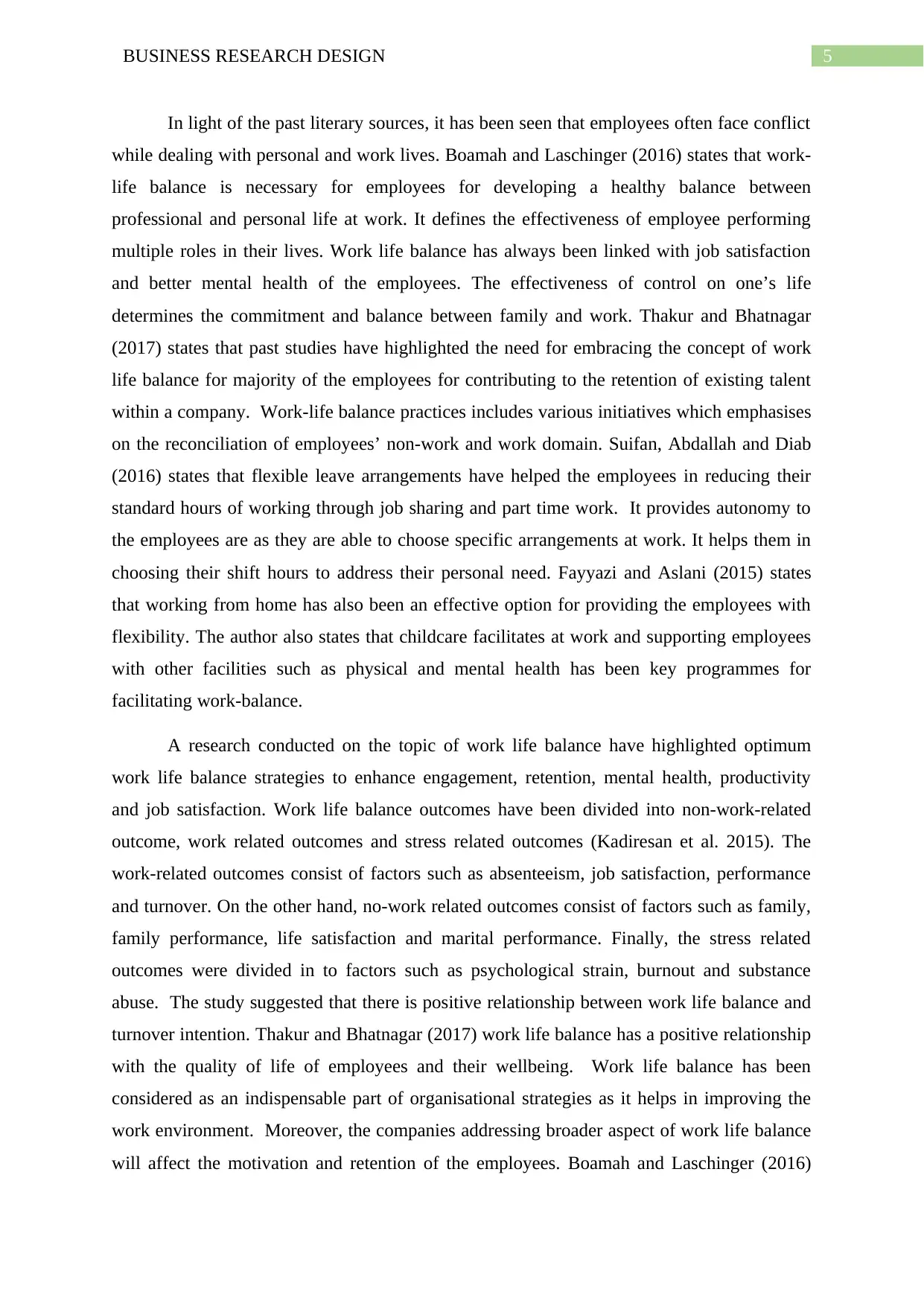
5BUSINESS RESEARCH DESIGN
In light of the past literary sources, it has been seen that employees often face conflict
while dealing with personal and work lives. Boamah and Laschinger (2016) states that work-
life balance is necessary for employees for developing a healthy balance between
professional and personal life at work. It defines the effectiveness of employee performing
multiple roles in their lives. Work life balance has always been linked with job satisfaction
and better mental health of the employees. The effectiveness of control on one’s life
determines the commitment and balance between family and work. Thakur and Bhatnagar
(2017) states that past studies have highlighted the need for embracing the concept of work
life balance for majority of the employees for contributing to the retention of existing talent
within a company. Work-life balance practices includes various initiatives which emphasises
on the reconciliation of employees’ non-work and work domain. Suifan, Abdallah and Diab
(2016) states that flexible leave arrangements have helped the employees in reducing their
standard hours of working through job sharing and part time work. It provides autonomy to
the employees are as they are able to choose specific arrangements at work. It helps them in
choosing their shift hours to address their personal need. Fayyazi and Aslani (2015) states
that working from home has also been an effective option for providing the employees with
flexibility. The author also states that childcare facilitates at work and supporting employees
with other facilities such as physical and mental health has been key programmes for
facilitating work-balance.
A research conducted on the topic of work life balance have highlighted optimum
work life balance strategies to enhance engagement, retention, mental health, productivity
and job satisfaction. Work life balance outcomes have been divided into non-work-related
outcome, work related outcomes and stress related outcomes (Kadiresan et al. 2015). The
work-related outcomes consist of factors such as absenteeism, job satisfaction, performance
and turnover. On the other hand, no-work related outcomes consist of factors such as family,
family performance, life satisfaction and marital performance. Finally, the stress related
outcomes were divided in to factors such as psychological strain, burnout and substance
abuse. The study suggested that there is positive relationship between work life balance and
turnover intention. Thakur and Bhatnagar (2017) work life balance has a positive relationship
with the quality of life of employees and their wellbeing. Work life balance has been
considered as an indispensable part of organisational strategies as it helps in improving the
work environment. Moreover, the companies addressing broader aspect of work life balance
will affect the motivation and retention of the employees. Boamah and Laschinger (2016)
In light of the past literary sources, it has been seen that employees often face conflict
while dealing with personal and work lives. Boamah and Laschinger (2016) states that work-
life balance is necessary for employees for developing a healthy balance between
professional and personal life at work. It defines the effectiveness of employee performing
multiple roles in their lives. Work life balance has always been linked with job satisfaction
and better mental health of the employees. The effectiveness of control on one’s life
determines the commitment and balance between family and work. Thakur and Bhatnagar
(2017) states that past studies have highlighted the need for embracing the concept of work
life balance for majority of the employees for contributing to the retention of existing talent
within a company. Work-life balance practices includes various initiatives which emphasises
on the reconciliation of employees’ non-work and work domain. Suifan, Abdallah and Diab
(2016) states that flexible leave arrangements have helped the employees in reducing their
standard hours of working through job sharing and part time work. It provides autonomy to
the employees are as they are able to choose specific arrangements at work. It helps them in
choosing their shift hours to address their personal need. Fayyazi and Aslani (2015) states
that working from home has also been an effective option for providing the employees with
flexibility. The author also states that childcare facilitates at work and supporting employees
with other facilities such as physical and mental health has been key programmes for
facilitating work-balance.
A research conducted on the topic of work life balance have highlighted optimum
work life balance strategies to enhance engagement, retention, mental health, productivity
and job satisfaction. Work life balance outcomes have been divided into non-work-related
outcome, work related outcomes and stress related outcomes (Kadiresan et al. 2015). The
work-related outcomes consist of factors such as absenteeism, job satisfaction, performance
and turnover. On the other hand, no-work related outcomes consist of factors such as family,
family performance, life satisfaction and marital performance. Finally, the stress related
outcomes were divided in to factors such as psychological strain, burnout and substance
abuse. The study suggested that there is positive relationship between work life balance and
turnover intention. Thakur and Bhatnagar (2017) work life balance has a positive relationship
with the quality of life of employees and their wellbeing. Work life balance has been
considered as an indispensable part of organisational strategies as it helps in improving the
work environment. Moreover, the companies addressing broader aspect of work life balance
will affect the motivation and retention of the employees. Boamah and Laschinger (2016)
⊘ This is a preview!⊘
Do you want full access?
Subscribe today to unlock all pages.

Trusted by 1+ million students worldwide
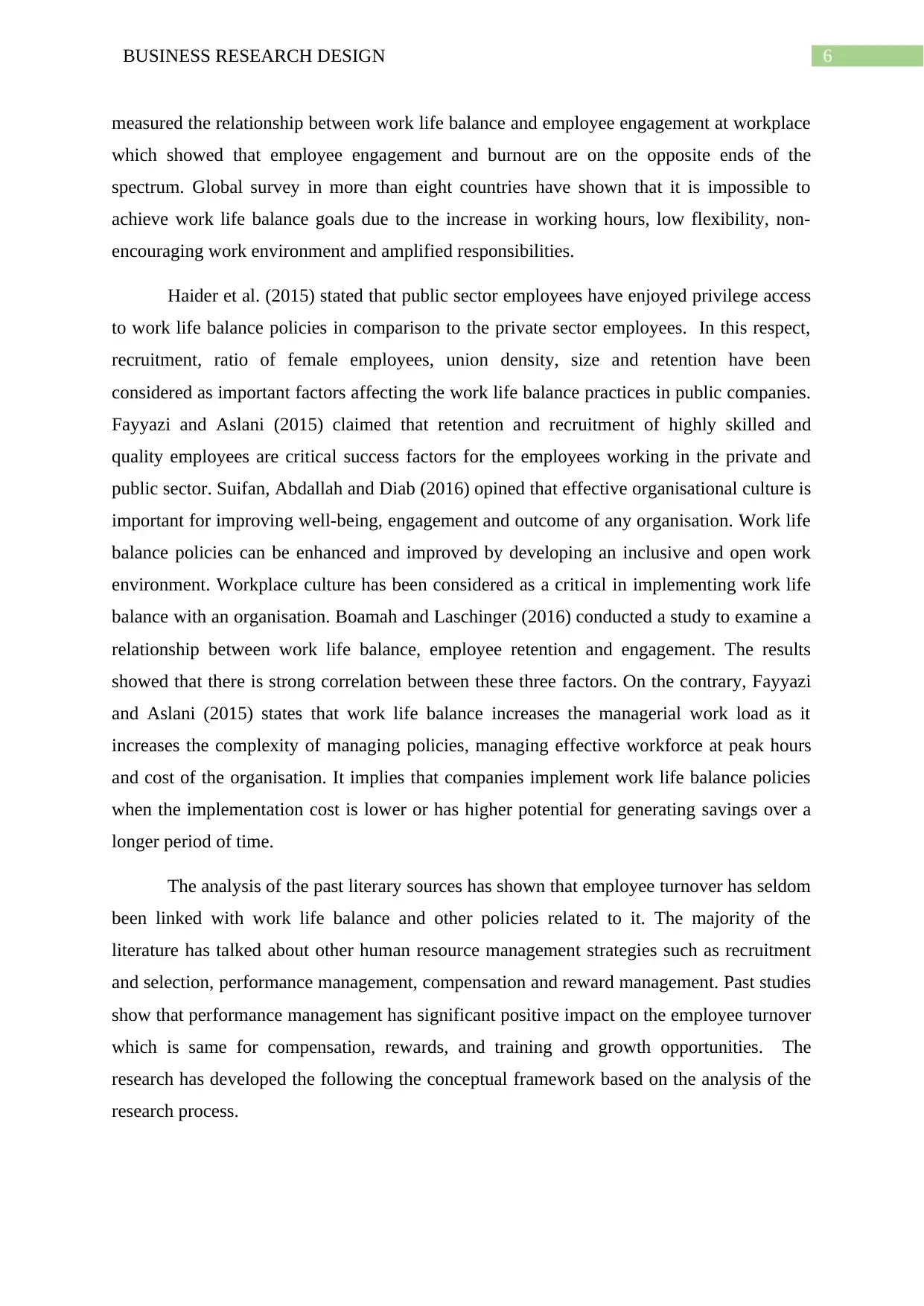
6BUSINESS RESEARCH DESIGN
measured the relationship between work life balance and employee engagement at workplace
which showed that employee engagement and burnout are on the opposite ends of the
spectrum. Global survey in more than eight countries have shown that it is impossible to
achieve work life balance goals due to the increase in working hours, low flexibility, non-
encouraging work environment and amplified responsibilities.
Haider et al. (2015) stated that public sector employees have enjoyed privilege access
to work life balance policies in comparison to the private sector employees. In this respect,
recruitment, ratio of female employees, union density, size and retention have been
considered as important factors affecting the work life balance practices in public companies.
Fayyazi and Aslani (2015) claimed that retention and recruitment of highly skilled and
quality employees are critical success factors for the employees working in the private and
public sector. Suifan, Abdallah and Diab (2016) opined that effective organisational culture is
important for improving well-being, engagement and outcome of any organisation. Work life
balance policies can be enhanced and improved by developing an inclusive and open work
environment. Workplace culture has been considered as a critical in implementing work life
balance with an organisation. Boamah and Laschinger (2016) conducted a study to examine a
relationship between work life balance, employee retention and engagement. The results
showed that there is strong correlation between these three factors. On the contrary, Fayyazi
and Aslani (2015) states that work life balance increases the managerial work load as it
increases the complexity of managing policies, managing effective workforce at peak hours
and cost of the organisation. It implies that companies implement work life balance policies
when the implementation cost is lower or has higher potential for generating savings over a
longer period of time.
The analysis of the past literary sources has shown that employee turnover has seldom
been linked with work life balance and other policies related to it. The majority of the
literature has talked about other human resource management strategies such as recruitment
and selection, performance management, compensation and reward management. Past studies
show that performance management has significant positive impact on the employee turnover
which is same for compensation, rewards, and training and growth opportunities. The
research has developed the following the conceptual framework based on the analysis of the
research process.
measured the relationship between work life balance and employee engagement at workplace
which showed that employee engagement and burnout are on the opposite ends of the
spectrum. Global survey in more than eight countries have shown that it is impossible to
achieve work life balance goals due to the increase in working hours, low flexibility, non-
encouraging work environment and amplified responsibilities.
Haider et al. (2015) stated that public sector employees have enjoyed privilege access
to work life balance policies in comparison to the private sector employees. In this respect,
recruitment, ratio of female employees, union density, size and retention have been
considered as important factors affecting the work life balance practices in public companies.
Fayyazi and Aslani (2015) claimed that retention and recruitment of highly skilled and
quality employees are critical success factors for the employees working in the private and
public sector. Suifan, Abdallah and Diab (2016) opined that effective organisational culture is
important for improving well-being, engagement and outcome of any organisation. Work life
balance policies can be enhanced and improved by developing an inclusive and open work
environment. Workplace culture has been considered as a critical in implementing work life
balance with an organisation. Boamah and Laschinger (2016) conducted a study to examine a
relationship between work life balance, employee retention and engagement. The results
showed that there is strong correlation between these three factors. On the contrary, Fayyazi
and Aslani (2015) states that work life balance increases the managerial work load as it
increases the complexity of managing policies, managing effective workforce at peak hours
and cost of the organisation. It implies that companies implement work life balance policies
when the implementation cost is lower or has higher potential for generating savings over a
longer period of time.
The analysis of the past literary sources has shown that employee turnover has seldom
been linked with work life balance and other policies related to it. The majority of the
literature has talked about other human resource management strategies such as recruitment
and selection, performance management, compensation and reward management. Past studies
show that performance management has significant positive impact on the employee turnover
which is same for compensation, rewards, and training and growth opportunities. The
research has developed the following the conceptual framework based on the analysis of the
research process.
Paraphrase This Document
Need a fresh take? Get an instant paraphrase of this document with our AI Paraphraser
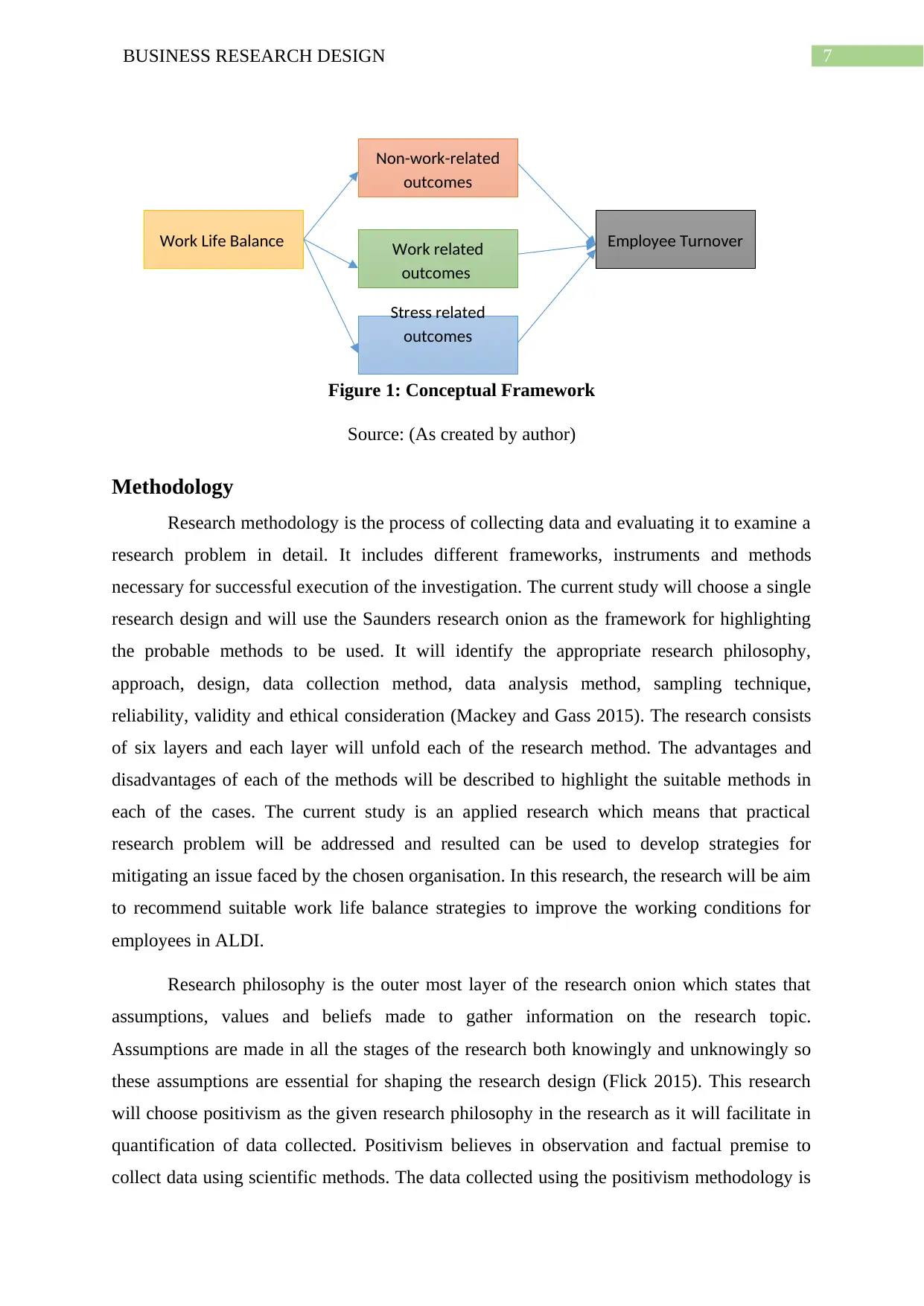
7BUSINESS RESEARCH DESIGN
Figure 1: Conceptual Framework
Source: (As created by author)
Methodology
Research methodology is the process of collecting data and evaluating it to examine a
research problem in detail. It includes different frameworks, instruments and methods
necessary for successful execution of the investigation. The current study will choose a single
research design and will use the Saunders research onion as the framework for highlighting
the probable methods to be used. It will identify the appropriate research philosophy,
approach, design, data collection method, data analysis method, sampling technique,
reliability, validity and ethical consideration (Mackey and Gass 2015). The research consists
of six layers and each layer will unfold each of the research method. The advantages and
disadvantages of each of the methods will be described to highlight the suitable methods in
each of the cases. The current study is an applied research which means that practical
research problem will be addressed and resulted can be used to develop strategies for
mitigating an issue faced by the chosen organisation. In this research, the research will be aim
to recommend suitable work life balance strategies to improve the working conditions for
employees in ALDI.
Research philosophy is the outer most layer of the research onion which states that
assumptions, values and beliefs made to gather information on the research topic.
Assumptions are made in all the stages of the research both knowingly and unknowingly so
these assumptions are essential for shaping the research design (Flick 2015). This research
will choose positivism as the given research philosophy in the research as it will facilitate in
quantification of data collected. Positivism believes in observation and factual premise to
collect data using scientific methods. The data collected using the positivism methodology is
Work Life Balance
Stress related
outcomes
Non-work-related
outcomes
Employee TurnoverWork related
outcomes
Figure 1: Conceptual Framework
Source: (As created by author)
Methodology
Research methodology is the process of collecting data and evaluating it to examine a
research problem in detail. It includes different frameworks, instruments and methods
necessary for successful execution of the investigation. The current study will choose a single
research design and will use the Saunders research onion as the framework for highlighting
the probable methods to be used. It will identify the appropriate research philosophy,
approach, design, data collection method, data analysis method, sampling technique,
reliability, validity and ethical consideration (Mackey and Gass 2015). The research consists
of six layers and each layer will unfold each of the research method. The advantages and
disadvantages of each of the methods will be described to highlight the suitable methods in
each of the cases. The current study is an applied research which means that practical
research problem will be addressed and resulted can be used to develop strategies for
mitigating an issue faced by the chosen organisation. In this research, the research will be aim
to recommend suitable work life balance strategies to improve the working conditions for
employees in ALDI.
Research philosophy is the outer most layer of the research onion which states that
assumptions, values and beliefs made to gather information on the research topic.
Assumptions are made in all the stages of the research both knowingly and unknowingly so
these assumptions are essential for shaping the research design (Flick 2015). This research
will choose positivism as the given research philosophy in the research as it will facilitate in
quantification of data collected. Positivism believes in observation and factual premise to
collect data using scientific methods. The data collected using the positivism methodology is
Work Life Balance
Stress related
outcomes
Non-work-related
outcomes
Employee TurnoverWork related
outcomes
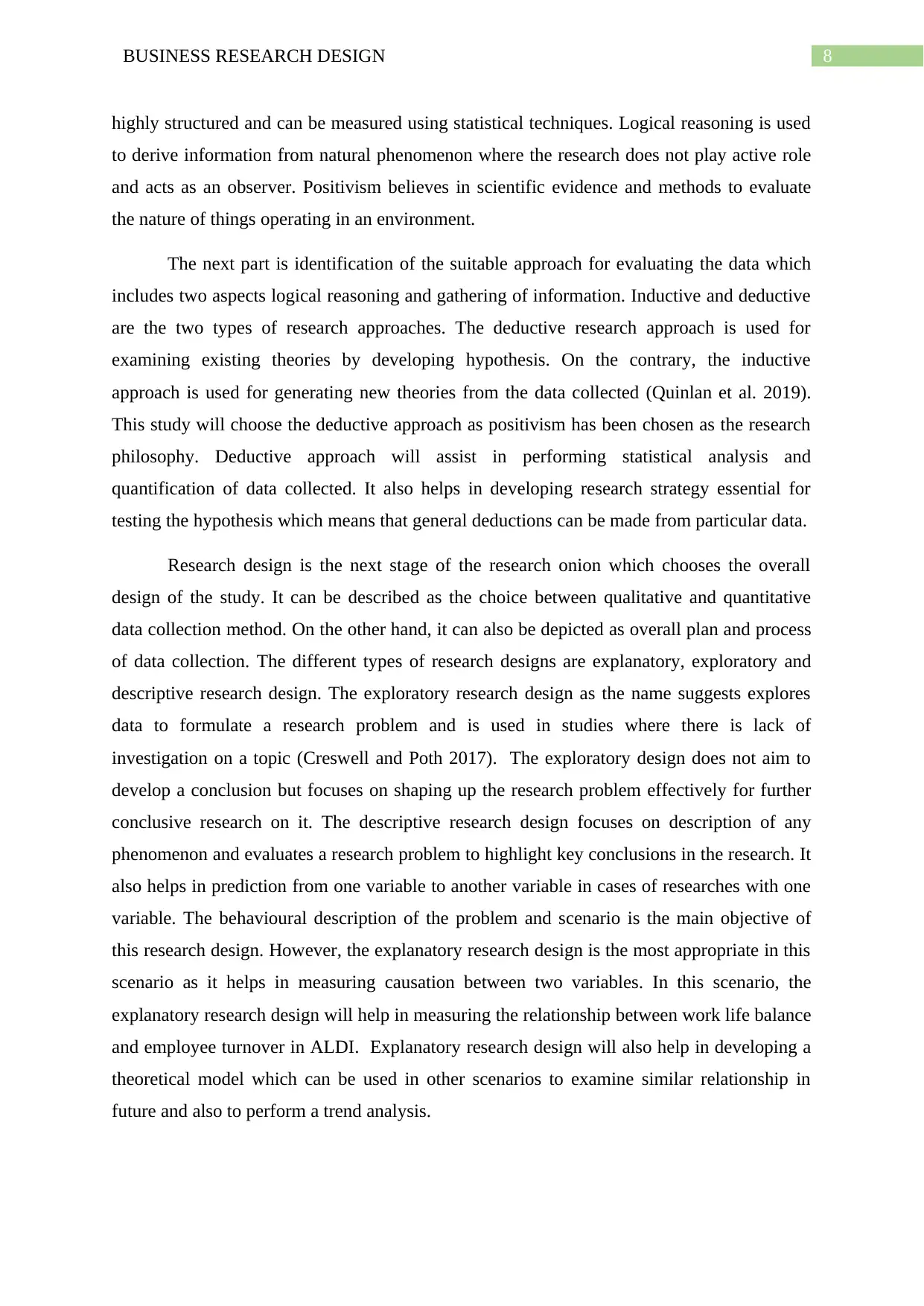
8BUSINESS RESEARCH DESIGN
highly structured and can be measured using statistical techniques. Logical reasoning is used
to derive information from natural phenomenon where the research does not play active role
and acts as an observer. Positivism believes in scientific evidence and methods to evaluate
the nature of things operating in an environment.
The next part is identification of the suitable approach for evaluating the data which
includes two aspects logical reasoning and gathering of information. Inductive and deductive
are the two types of research approaches. The deductive research approach is used for
examining existing theories by developing hypothesis. On the contrary, the inductive
approach is used for generating new theories from the data collected (Quinlan et al. 2019).
This study will choose the deductive approach as positivism has been chosen as the research
philosophy. Deductive approach will assist in performing statistical analysis and
quantification of data collected. It also helps in developing research strategy essential for
testing the hypothesis which means that general deductions can be made from particular data.
Research design is the next stage of the research onion which chooses the overall
design of the study. It can be described as the choice between qualitative and quantitative
data collection method. On the other hand, it can also be depicted as overall plan and process
of data collection. The different types of research designs are explanatory, exploratory and
descriptive research design. The exploratory research design as the name suggests explores
data to formulate a research problem and is used in studies where there is lack of
investigation on a topic (Creswell and Poth 2017). The exploratory design does not aim to
develop a conclusion but focuses on shaping up the research problem effectively for further
conclusive research on it. The descriptive research design focuses on description of any
phenomenon and evaluates a research problem to highlight key conclusions in the research. It
also helps in prediction from one variable to another variable in cases of researches with one
variable. The behavioural description of the problem and scenario is the main objective of
this research design. However, the explanatory research design is the most appropriate in this
scenario as it helps in measuring causation between two variables. In this scenario, the
explanatory research design will help in measuring the relationship between work life balance
and employee turnover in ALDI. Explanatory research design will also help in developing a
theoretical model which can be used in other scenarios to examine similar relationship in
future and also to perform a trend analysis.
highly structured and can be measured using statistical techniques. Logical reasoning is used
to derive information from natural phenomenon where the research does not play active role
and acts as an observer. Positivism believes in scientific evidence and methods to evaluate
the nature of things operating in an environment.
The next part is identification of the suitable approach for evaluating the data which
includes two aspects logical reasoning and gathering of information. Inductive and deductive
are the two types of research approaches. The deductive research approach is used for
examining existing theories by developing hypothesis. On the contrary, the inductive
approach is used for generating new theories from the data collected (Quinlan et al. 2019).
This study will choose the deductive approach as positivism has been chosen as the research
philosophy. Deductive approach will assist in performing statistical analysis and
quantification of data collected. It also helps in developing research strategy essential for
testing the hypothesis which means that general deductions can be made from particular data.
Research design is the next stage of the research onion which chooses the overall
design of the study. It can be described as the choice between qualitative and quantitative
data collection method. On the other hand, it can also be depicted as overall plan and process
of data collection. The different types of research designs are explanatory, exploratory and
descriptive research design. The exploratory research design as the name suggests explores
data to formulate a research problem and is used in studies where there is lack of
investigation on a topic (Creswell and Poth 2017). The exploratory design does not aim to
develop a conclusion but focuses on shaping up the research problem effectively for further
conclusive research on it. The descriptive research design focuses on description of any
phenomenon and evaluates a research problem to highlight key conclusions in the research. It
also helps in prediction from one variable to another variable in cases of researches with one
variable. The behavioural description of the problem and scenario is the main objective of
this research design. However, the explanatory research design is the most appropriate in this
scenario as it helps in measuring causation between two variables. In this scenario, the
explanatory research design will help in measuring the relationship between work life balance
and employee turnover in ALDI. Explanatory research design will also help in developing a
theoretical model which can be used in other scenarios to examine similar relationship in
future and also to perform a trend analysis.
⊘ This is a preview!⊘
Do you want full access?
Subscribe today to unlock all pages.

Trusted by 1+ million students worldwide
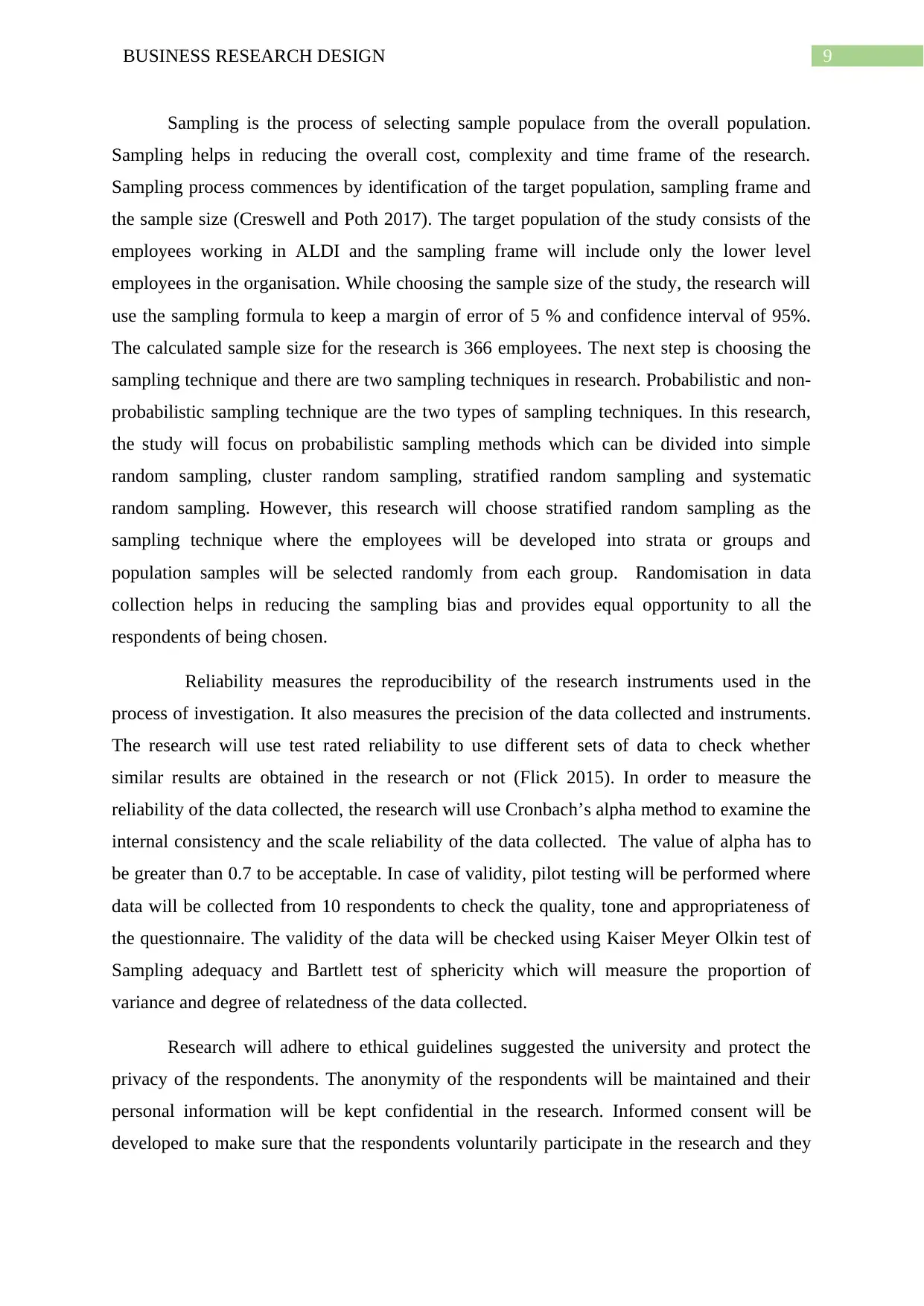
9BUSINESS RESEARCH DESIGN
Sampling is the process of selecting sample populace from the overall population.
Sampling helps in reducing the overall cost, complexity and time frame of the research.
Sampling process commences by identification of the target population, sampling frame and
the sample size (Creswell and Poth 2017). The target population of the study consists of the
employees working in ALDI and the sampling frame will include only the lower level
employees in the organisation. While choosing the sample size of the study, the research will
use the sampling formula to keep a margin of error of 5 % and confidence interval of 95%.
The calculated sample size for the research is 366 employees. The next step is choosing the
sampling technique and there are two sampling techniques in research. Probabilistic and non-
probabilistic sampling technique are the two types of sampling techniques. In this research,
the study will focus on probabilistic sampling methods which can be divided into simple
random sampling, cluster random sampling, stratified random sampling and systematic
random sampling. However, this research will choose stratified random sampling as the
sampling technique where the employees will be developed into strata or groups and
population samples will be selected randomly from each group. Randomisation in data
collection helps in reducing the sampling bias and provides equal opportunity to all the
respondents of being chosen.
Reliability measures the reproducibility of the research instruments used in the
process of investigation. It also measures the precision of the data collected and instruments.
The research will use test rated reliability to use different sets of data to check whether
similar results are obtained in the research or not (Flick 2015). In order to measure the
reliability of the data collected, the research will use Cronbach’s alpha method to examine the
internal consistency and the scale reliability of the data collected. The value of alpha has to
be greater than 0.7 to be acceptable. In case of validity, pilot testing will be performed where
data will be collected from 10 respondents to check the quality, tone and appropriateness of
the questionnaire. The validity of the data will be checked using Kaiser Meyer Olkin test of
Sampling adequacy and Bartlett test of sphericity which will measure the proportion of
variance and degree of relatedness of the data collected.
Research will adhere to ethical guidelines suggested the university and protect the
privacy of the respondents. The anonymity of the respondents will be maintained and their
personal information will be kept confidential in the research. Informed consent will be
developed to make sure that the respondents voluntarily participate in the research and they
Sampling is the process of selecting sample populace from the overall population.
Sampling helps in reducing the overall cost, complexity and time frame of the research.
Sampling process commences by identification of the target population, sampling frame and
the sample size (Creswell and Poth 2017). The target population of the study consists of the
employees working in ALDI and the sampling frame will include only the lower level
employees in the organisation. While choosing the sample size of the study, the research will
use the sampling formula to keep a margin of error of 5 % and confidence interval of 95%.
The calculated sample size for the research is 366 employees. The next step is choosing the
sampling technique and there are two sampling techniques in research. Probabilistic and non-
probabilistic sampling technique are the two types of sampling techniques. In this research,
the study will focus on probabilistic sampling methods which can be divided into simple
random sampling, cluster random sampling, stratified random sampling and systematic
random sampling. However, this research will choose stratified random sampling as the
sampling technique where the employees will be developed into strata or groups and
population samples will be selected randomly from each group. Randomisation in data
collection helps in reducing the sampling bias and provides equal opportunity to all the
respondents of being chosen.
Reliability measures the reproducibility of the research instruments used in the
process of investigation. It also measures the precision of the data collected and instruments.
The research will use test rated reliability to use different sets of data to check whether
similar results are obtained in the research or not (Flick 2015). In order to measure the
reliability of the data collected, the research will use Cronbach’s alpha method to examine the
internal consistency and the scale reliability of the data collected. The value of alpha has to
be greater than 0.7 to be acceptable. In case of validity, pilot testing will be performed where
data will be collected from 10 respondents to check the quality, tone and appropriateness of
the questionnaire. The validity of the data will be checked using Kaiser Meyer Olkin test of
Sampling adequacy and Bartlett test of sphericity which will measure the proportion of
variance and degree of relatedness of the data collected.
Research will adhere to ethical guidelines suggested the university and protect the
privacy of the respondents. The anonymity of the respondents will be maintained and their
personal information will be kept confidential in the research. Informed consent will be
developed to make sure that the respondents voluntarily participate in the research and they
Paraphrase This Document
Need a fresh take? Get an instant paraphrase of this document with our AI Paraphraser
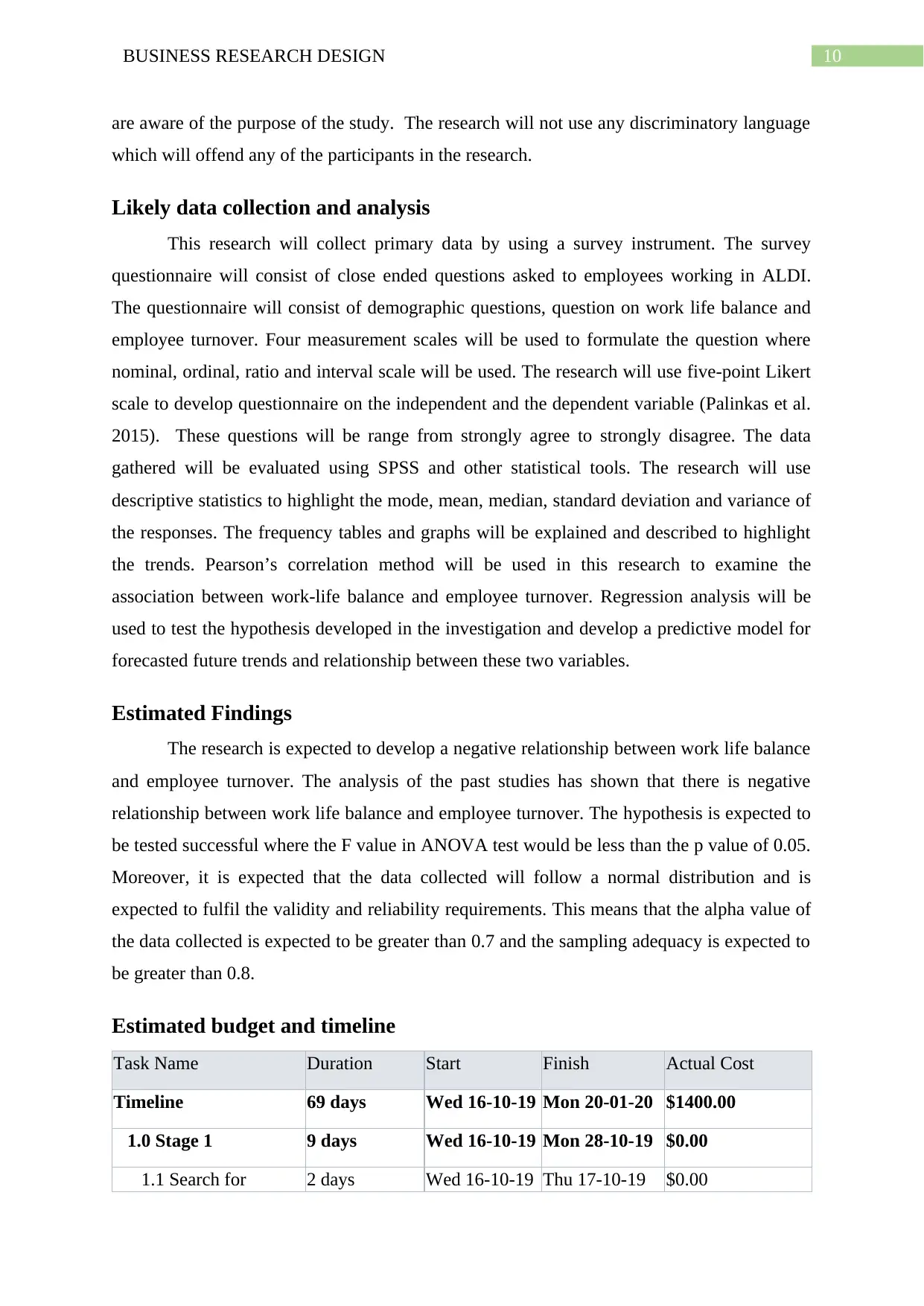
10BUSINESS RESEARCH DESIGN
are aware of the purpose of the study. The research will not use any discriminatory language
which will offend any of the participants in the research.
Likely data collection and analysis
This research will collect primary data by using a survey instrument. The survey
questionnaire will consist of close ended questions asked to employees working in ALDI.
The questionnaire will consist of demographic questions, question on work life balance and
employee turnover. Four measurement scales will be used to formulate the question where
nominal, ordinal, ratio and interval scale will be used. The research will use five-point Likert
scale to develop questionnaire on the independent and the dependent variable (Palinkas et al.
2015). These questions will be range from strongly agree to strongly disagree. The data
gathered will be evaluated using SPSS and other statistical tools. The research will use
descriptive statistics to highlight the mode, mean, median, standard deviation and variance of
the responses. The frequency tables and graphs will be explained and described to highlight
the trends. Pearson’s correlation method will be used in this research to examine the
association between work-life balance and employee turnover. Regression analysis will be
used to test the hypothesis developed in the investigation and develop a predictive model for
forecasted future trends and relationship between these two variables.
Estimated Findings
The research is expected to develop a negative relationship between work life balance
and employee turnover. The analysis of the past studies has shown that there is negative
relationship between work life balance and employee turnover. The hypothesis is expected to
be tested successful where the F value in ANOVA test would be less than the p value of 0.05.
Moreover, it is expected that the data collected will follow a normal distribution and is
expected to fulfil the validity and reliability requirements. This means that the alpha value of
the data collected is expected to be greater than 0.7 and the sampling adequacy is expected to
be greater than 0.8.
Estimated budget and timeline
Task Name Duration Start Finish Actual Cost
Timeline 69 days Wed 16-10-19 Mon 20-01-20 $1400.00
1.0 Stage 1 9 days Wed 16-10-19 Mon 28-10-19 $0.00
1.1 Search for 2 days Wed 16-10-19 Thu 17-10-19 $0.00
are aware of the purpose of the study. The research will not use any discriminatory language
which will offend any of the participants in the research.
Likely data collection and analysis
This research will collect primary data by using a survey instrument. The survey
questionnaire will consist of close ended questions asked to employees working in ALDI.
The questionnaire will consist of demographic questions, question on work life balance and
employee turnover. Four measurement scales will be used to formulate the question where
nominal, ordinal, ratio and interval scale will be used. The research will use five-point Likert
scale to develop questionnaire on the independent and the dependent variable (Palinkas et al.
2015). These questions will be range from strongly agree to strongly disagree. The data
gathered will be evaluated using SPSS and other statistical tools. The research will use
descriptive statistics to highlight the mode, mean, median, standard deviation and variance of
the responses. The frequency tables and graphs will be explained and described to highlight
the trends. Pearson’s correlation method will be used in this research to examine the
association between work-life balance and employee turnover. Regression analysis will be
used to test the hypothesis developed in the investigation and develop a predictive model for
forecasted future trends and relationship between these two variables.
Estimated Findings
The research is expected to develop a negative relationship between work life balance
and employee turnover. The analysis of the past studies has shown that there is negative
relationship between work life balance and employee turnover. The hypothesis is expected to
be tested successful where the F value in ANOVA test would be less than the p value of 0.05.
Moreover, it is expected that the data collected will follow a normal distribution and is
expected to fulfil the validity and reliability requirements. This means that the alpha value of
the data collected is expected to be greater than 0.7 and the sampling adequacy is expected to
be greater than 0.8.
Estimated budget and timeline
Task Name Duration Start Finish Actual Cost
Timeline 69 days Wed 16-10-19 Mon 20-01-20 $1400.00
1.0 Stage 1 9 days Wed 16-10-19 Mon 28-10-19 $0.00
1.1 Search for 2 days Wed 16-10-19 Thu 17-10-19 $0.00
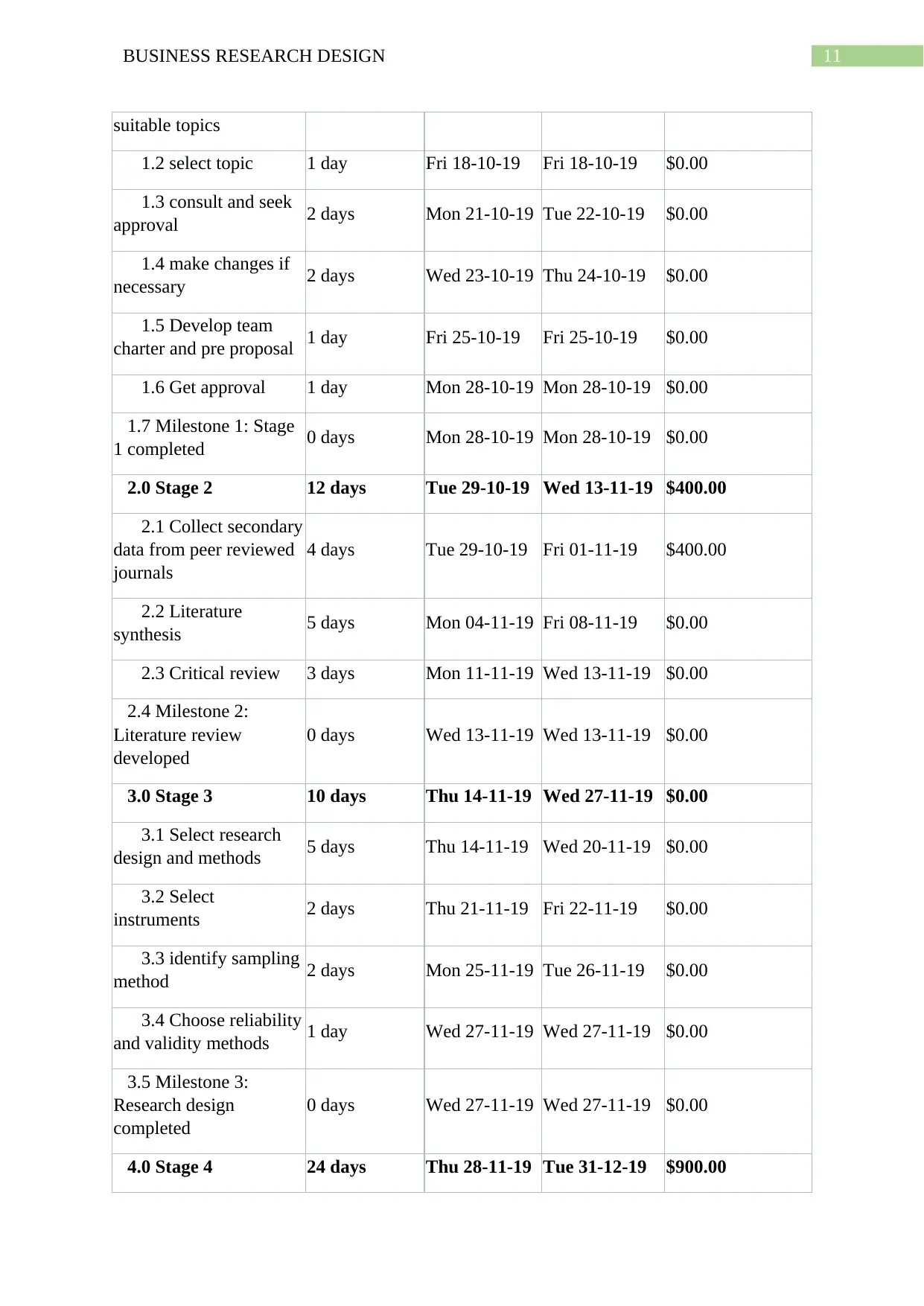
11BUSINESS RESEARCH DESIGN
suitable topics
1.2 select topic 1 day Fri 18-10-19 Fri 18-10-19 $0.00
1.3 consult and seek
approval 2 days Mon 21-10-19 Tue 22-10-19 $0.00
1.4 make changes if
necessary 2 days Wed 23-10-19 Thu 24-10-19 $0.00
1.5 Develop team
charter and pre proposal 1 day Fri 25-10-19 Fri 25-10-19 $0.00
1.6 Get approval 1 day Mon 28-10-19 Mon 28-10-19 $0.00
1.7 Milestone 1: Stage
1 completed 0 days Mon 28-10-19 Mon 28-10-19 $0.00
2.0 Stage 2 12 days Tue 29-10-19 Wed 13-11-19 $400.00
2.1 Collect secondary
data from peer reviewed
journals
4 days Tue 29-10-19 Fri 01-11-19 $400.00
2.2 Literature
synthesis 5 days Mon 04-11-19 Fri 08-11-19 $0.00
2.3 Critical review 3 days Mon 11-11-19 Wed 13-11-19 $0.00
2.4 Milestone 2:
Literature review
developed
0 days Wed 13-11-19 Wed 13-11-19 $0.00
3.0 Stage 3 10 days Thu 14-11-19 Wed 27-11-19 $0.00
3.1 Select research
design and methods 5 days Thu 14-11-19 Wed 20-11-19 $0.00
3.2 Select
instruments 2 days Thu 21-11-19 Fri 22-11-19 $0.00
3.3 identify sampling
method 2 days Mon 25-11-19 Tue 26-11-19 $0.00
3.4 Choose reliability
and validity methods 1 day Wed 27-11-19 Wed 27-11-19 $0.00
3.5 Milestone 3:
Research design
completed
0 days Wed 27-11-19 Wed 27-11-19 $0.00
4.0 Stage 4 24 days Thu 28-11-19 Tue 31-12-19 $900.00
suitable topics
1.2 select topic 1 day Fri 18-10-19 Fri 18-10-19 $0.00
1.3 consult and seek
approval 2 days Mon 21-10-19 Tue 22-10-19 $0.00
1.4 make changes if
necessary 2 days Wed 23-10-19 Thu 24-10-19 $0.00
1.5 Develop team
charter and pre proposal 1 day Fri 25-10-19 Fri 25-10-19 $0.00
1.6 Get approval 1 day Mon 28-10-19 Mon 28-10-19 $0.00
1.7 Milestone 1: Stage
1 completed 0 days Mon 28-10-19 Mon 28-10-19 $0.00
2.0 Stage 2 12 days Tue 29-10-19 Wed 13-11-19 $400.00
2.1 Collect secondary
data from peer reviewed
journals
4 days Tue 29-10-19 Fri 01-11-19 $400.00
2.2 Literature
synthesis 5 days Mon 04-11-19 Fri 08-11-19 $0.00
2.3 Critical review 3 days Mon 11-11-19 Wed 13-11-19 $0.00
2.4 Milestone 2:
Literature review
developed
0 days Wed 13-11-19 Wed 13-11-19 $0.00
3.0 Stage 3 10 days Thu 14-11-19 Wed 27-11-19 $0.00
3.1 Select research
design and methods 5 days Thu 14-11-19 Wed 20-11-19 $0.00
3.2 Select
instruments 2 days Thu 21-11-19 Fri 22-11-19 $0.00
3.3 identify sampling
method 2 days Mon 25-11-19 Tue 26-11-19 $0.00
3.4 Choose reliability
and validity methods 1 day Wed 27-11-19 Wed 27-11-19 $0.00
3.5 Milestone 3:
Research design
completed
0 days Wed 27-11-19 Wed 27-11-19 $0.00
4.0 Stage 4 24 days Thu 28-11-19 Tue 31-12-19 $900.00
⊘ This is a preview!⊘
Do you want full access?
Subscribe today to unlock all pages.

Trusted by 1+ million students worldwide
1 out of 18
Related Documents
Your All-in-One AI-Powered Toolkit for Academic Success.
+13062052269
info@desklib.com
Available 24*7 on WhatsApp / Email
![[object Object]](/_next/static/media/star-bottom.7253800d.svg)
Unlock your academic potential
Copyright © 2020–2025 A2Z Services. All Rights Reserved. Developed and managed by ZUCOL.





